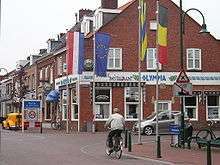Putte, Netherlands

Putte is part of the Dutch municipality of Woensdrecht, and had 3751 inhabitants as of 1 January 2008. The village lies on and extends over the border between the Netherlands and Belgium, the Belgian part being Putte, Kapellen.
The former municipality (which merged with several other communities to form the municipality of Woensdrecht in 1997) covered 18,56 sq. kilometres, of which much is forest and moorland.
Putte is the burial place of the 17th century Antwerp painter Jacob Jordaens who, as a Protestant, could not be buried in his Roman Catholic hometown. A Jordaens monument stands on the place of the former Protestant cemetery. The village also has three extensive Jewish cemeteries with many graves of Belgian Jews.
The noted artist Marguerite Wildenhain, who was forced to leave her teaching post in Germany because of her Jewish ancestry, came to Putte in 1933. She and her husband Franz established in the town a pottery shop called Het Kruikje (Little Jug) - which existed until the German invasion of the Netherlands in 1940, when Wildenhain was able to find refuge in the US.
External links
- J. Kuyper, Gemeente Atlas van Nederland, 1865-1870, "Putte". Map of the former municipality, around 1868.
- Border photos
Coordinates: 51°22′N 4°23′E / 51.367°N 4.383°E